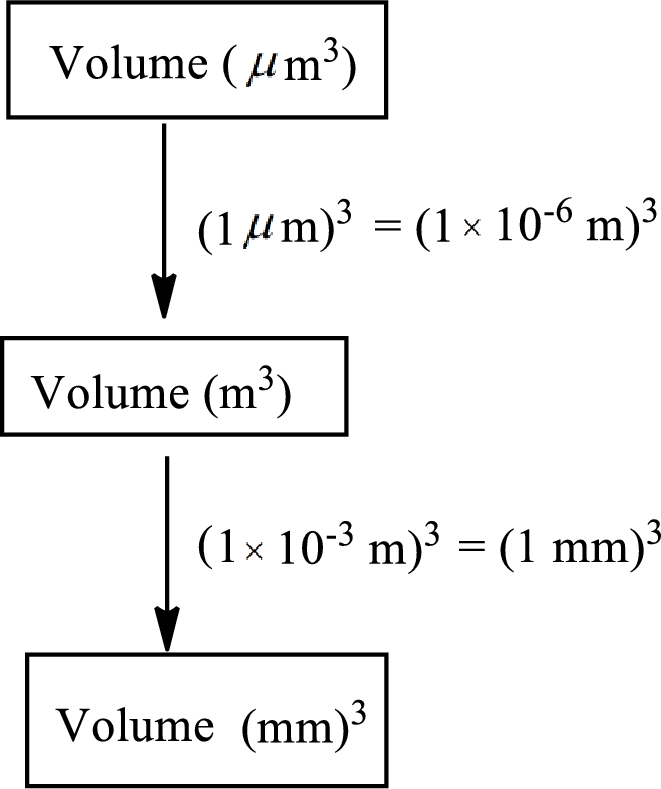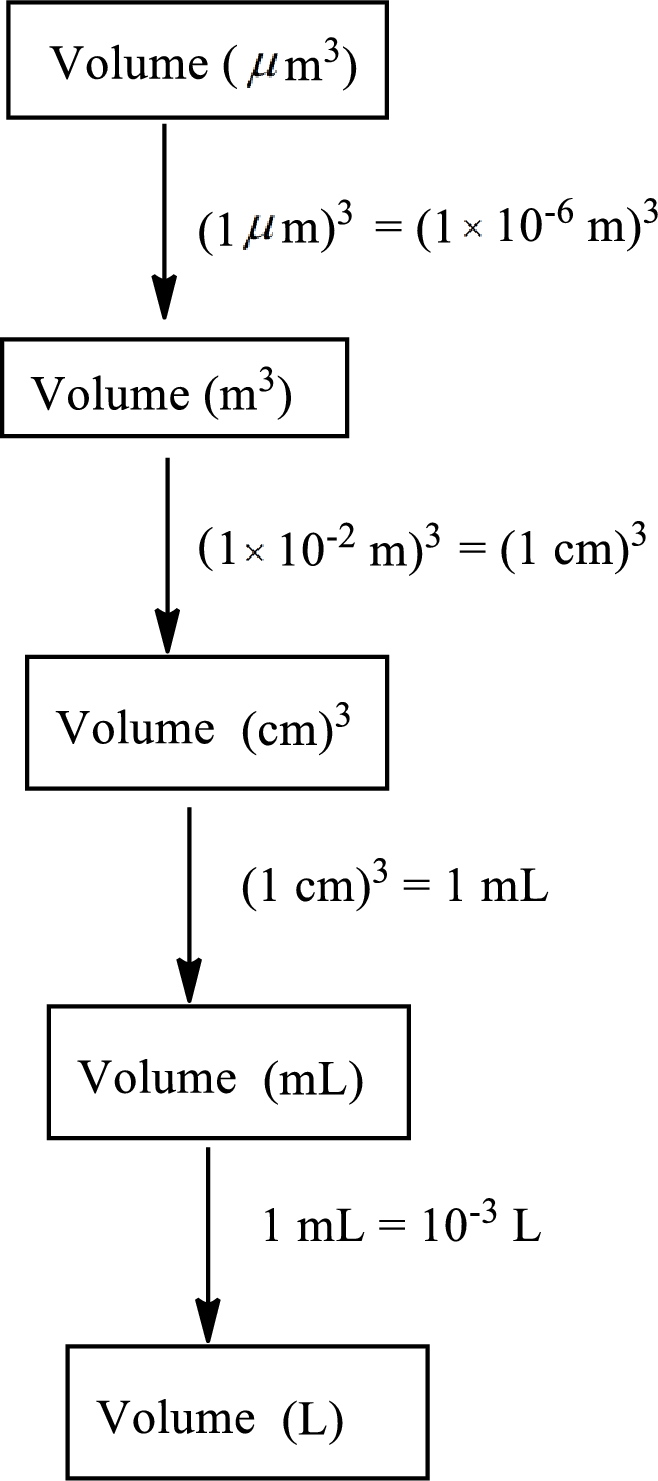
Concept explainers
(a)
Interpretation:
The volume of a bacterial cell in cubic millimeters (mm3) is to be calculated.
Concept introduction:
Volume is a physical quantity and its SI unit is cubic meter (m3). The volume of an object is equal to the product of the height, length, and breadth of the object. Length, breadth, and height of an object is measured in the units of length. Therefore, volume has the unit of length to the cubic power. The other unit of the volume are liter, milliliter, cubic decimeter, microliter.
The conversion of one unit into another can be done using a proper conversion factor. Conversion factors are the ratios that relate the two different units of a quantity. It is also known as dimensional analysis or factor label method.
In the unit conversion problems, the given information is multiplied by the conversion factors to obtain the desired information. The unit conversion can be done as follows:
(beginning unit)(Final unitbeginning unit)=Final unit
(a)
Answer to Problem 1.36P
The volume of a bacterial cell in cubic millimeters (mm3) is 2.56×10−9 mm3/cell.
Explanation of Solution
The volume of a bacterial cell in cubic micrometer (μm3) is 2.56 μm3.
The road map to calculate the volume of a bacterial cell in cubic millimeters (mm3) is as follows:

The conversion factor to convert volume from cubic micrometer (μm3) to cubic meter (m3) is,
(1 μm)3=(1×10−6 m)3
The conversion factor to convert volume from cubic meter (m3) to cubic millimeters (mm3) is,
(1×10−3 m)3=(1 mm)3
Convert the volume from cubic micrometer (μm3) to cubic millimeters (mm3) as:
Volume(mm3)=2.56 μm3((1×10−6 m)3(1 μm)3)((1 mm)3(1×10−3 m)3)=2.56×10−9 mm3/cell
The volume of a bacterial cell in cubic millimeters (mm3) is 2.56×10−9 mm3/cell.
(b)
Interpretation:
The volume of 105 bacterial cell in liter (L) is to be calculated.
Concept introduction:
Volume is a physical quantity and its SI unit is cubic meter (m3). The volume of an object is equal to the product of the height, length, and breadth of the object. Length, breadth, and height of an object is measured in the units of length. Therefore, volume has the unit of length to the cubic power. The other unit of the volume are liter, milliliter, cubic decimeter, microliter.
The conversion of one unit into another can be done using a proper conversion factor. Conversion factors are the ratios that relate the two different units of a quantity. It is also known as dimensional analysis or factor label method.
In the unit conversion problems, the given information is multiplied by the conversion factors to obtain the desired information. The unit conversion can be done as follows:
(beginning unit)(Final unitbeginning unit)=Final unit
(b)
Answer to Problem 1.36P
The volume of 105 bacterial cell in liter (L) is 10−10 L.
Explanation of Solution
The volume of a bacterial cell in cubic micrometer (μm3) is 2.56 μm3.
The road map to calculate the volume of 105 bacterial cell in liter (L) is as follows:

The conversion factor to convert volume from cubic micrometer (μm3) to cubic meter (m3) is,
(1 μm)3=(1×10−6 m)3
The conversion factor to convert volume from cubic meter (m3) to cubic centimeters (cm3) is,
(1×10−2 m)3=(1 cm)3
The conversion factor to convert volume from cubic centimeters (cm3) to milliliters (mL) is,
(1 cm)3=1 mL
The conversion factor to convert volume from milliliters (mL) to liter (L) is,
1 mL=10−3 L
Convert the volume from cubic micrometer (μm3) to liter (L) as:
Volume(L)=2.56 μm3((1×10−6 m)3(1 μm)3)((1 cm)3(1×10−2 m)3)(1 mL(1 cm)3)(10−3 L1 mL)=2.56×10−15 L/cell
Calculate the volume of 105 bacterial cell in liter (L) as:
Volume(L)=(105 cell)(2.56×10−15 L/cell)=2.56×10−10 L=10−10 L
The volume of 105 bacterial cell in liter (L) is 10−10 L.
Want to see more full solutions like this?
Chapter 1 Solutions
Chemistry: The Molecular Nature of Matter and Change
- Curved arrows are used to illustrate the flow of electrons. Using the provided starting and product structures, draw the curved electron-pushing arrows for the following reaction or mechanistic step(s). Be sure to account for all bond-breaking and bond-making steps. Problem 164 of N Select to Add Arrows CHI CH 1 1 1 Parrow_forwardusing these can you help me , I guess convert them to lewis dit structures or full drawn out skeletal and I guess is that what would help me depict the bond angle.arrow_forwardShow reaction mechanism with explanation.don't give Ai generated solutionarrow_forward
- Please answer the questions and provide detailed explanations.arrow_forwardShow reaction mechanism. Don't give Ai generated solutionarrow_forwardPlease answer the questions and provide detailed explanation. Please also include the Hydrogens that are on the molecule to show how many signals there are.arrow_forward
- Capp aktiv.com Part of Speech Table for Assi x Aktiv Learning App K Curved arrows are used to illustrate the flow of electrons. Using the provided starting and product structures, draw the curved electron-pushing arrows for the following reaction or mechanistic step(s). Be sure to account for all bond-breaking and bond-making steps. Problem 232 of 10 10: Mg Select to Add Arrows Br O H :0 CI:O H Mg THE + dy Undo Reset Done Brarrow_forwardPlease answer the question and provide a detailed drawing of the structure. If there will not be a new C – C bond, then the box under the drawing area will be checked. Will the following reaction make a molecule with a new C – C bond as its major product: Draw the major organic product or products, if the reaction will work. Be sure you use wedge and dash bonds if necessary, for example to distinguish between major products with different stereochemistry.arrow_forwardNeed help with witharrow_forward
- Please answer the questions and provide detailed explanations.arrow_forwardsolve pleasearrow_forwardPlease answer the question and provide a detailed drawing of the structure. If there will not be a new C – C bond, then the box under the drawing area will be checked. Will the following reaction make a molecule with a new C – C bond as its major product: Draw the major organic product or products, if the reaction will work. Be sure you use wedge and dash bonds if necessary, for example to distinguish between major products with different stereochemistry.arrow_forward
 ChemistryChemistryISBN:9781305957404Author:Steven S. Zumdahl, Susan A. Zumdahl, Donald J. DeCostePublisher:Cengage Learning
ChemistryChemistryISBN:9781305957404Author:Steven S. Zumdahl, Susan A. Zumdahl, Donald J. DeCostePublisher:Cengage Learning ChemistryChemistryISBN:9781259911156Author:Raymond Chang Dr., Jason Overby ProfessorPublisher:McGraw-Hill Education
ChemistryChemistryISBN:9781259911156Author:Raymond Chang Dr., Jason Overby ProfessorPublisher:McGraw-Hill Education Principles of Instrumental AnalysisChemistryISBN:9781305577213Author:Douglas A. Skoog, F. James Holler, Stanley R. CrouchPublisher:Cengage Learning
Principles of Instrumental AnalysisChemistryISBN:9781305577213Author:Douglas A. Skoog, F. James Holler, Stanley R. CrouchPublisher:Cengage Learning Organic ChemistryChemistryISBN:9780078021558Author:Janice Gorzynski Smith Dr.Publisher:McGraw-Hill Education
Organic ChemistryChemistryISBN:9780078021558Author:Janice Gorzynski Smith Dr.Publisher:McGraw-Hill Education Chemistry: Principles and ReactionsChemistryISBN:9781305079373Author:William L. Masterton, Cecile N. HurleyPublisher:Cengage Learning
Chemistry: Principles and ReactionsChemistryISBN:9781305079373Author:William L. Masterton, Cecile N. HurleyPublisher:Cengage Learning Elementary Principles of Chemical Processes, Bind...ChemistryISBN:9781118431221Author:Richard M. Felder, Ronald W. Rousseau, Lisa G. BullardPublisher:WILEY
Elementary Principles of Chemical Processes, Bind...ChemistryISBN:9781118431221Author:Richard M. Felder, Ronald W. Rousseau, Lisa G. BullardPublisher:WILEY





